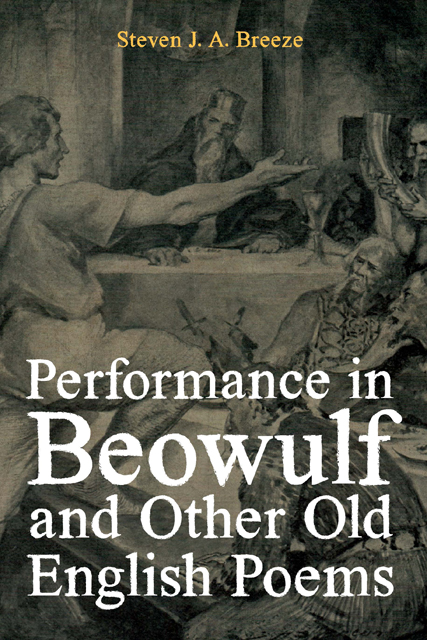Book contents
- Frontmatter
- Dedication
- Contents
- List of Illustrations and Tables
- Acknowledgements
- List of Abbreviations
- Poem Titles, Orthography, Editions, and Translations
- Introduction: Realising the Intangible
- 1 Instruments of the Poet: Exploiting the Old English Lexis
- 2 Multiformity and the Orality of Associative, Architectonic Poetics
- 3 Providence and Pleasure: Performance as Symbol
- 4 Storytelling in Beowulf and Meta-storytelling in Andreas
- 5 Wisdom and Power: Philosophies of Performance
- 6 Theme Songs: An English Tradition of Performance?
- 7 The Lure of the Lyre: Interpretation, Reenactment, and the Corpus
- Conclusion: ‘Poetic Performance’
- Bibliography
- Index
- Anglo-Saxon Studies
7 - The Lure of the Lyre: Interpretation, Reenactment, and the Corpus
Published online by Cambridge University Press: 20 December 2022
- Frontmatter
- Dedication
- Contents
- List of Illustrations and Tables
- Acknowledgements
- List of Abbreviations
- Poem Titles, Orthography, Editions, and Translations
- Introduction: Realising the Intangible
- 1 Instruments of the Poet: Exploiting the Old English Lexis
- 2 Multiformity and the Orality of Associative, Architectonic Poetics
- 3 Providence and Pleasure: Performance as Symbol
- 4 Storytelling in Beowulf and Meta-storytelling in Andreas
- 5 Wisdom and Power: Philosophies of Performance
- 6 Theme Songs: An English Tradition of Performance?
- 7 The Lure of the Lyre: Interpretation, Reenactment, and the Corpus
- Conclusion: ‘Poetic Performance’
- Bibliography
- Index
- Anglo-Saxon Studies
Summary
Historians and educators often say that to engage people with the past it should be brought to life, an undertaking that requires a process of interpretation. Historical reenactment is a principal method of interpreting and animating history, and all reenactment involves performance of some kind, such as battling (perhaps the most recognisable form of reenactment), cooking and feasting, and crafts, among other cultural activities. Essentially, it involves acting out a role. The nature of artistic performance means that storytelling, music, and drama have been principal modes of reenactment, of bringing the past to life. Aligned to this culture of reenactment is the phenomenon of presentation and demonstration, particularly in education settings. Anecdotally, this author has witnessed the benefits of introducing performances and instruments in such settings. For instance, when a lyre reconstruction is brought out at a talk or in the classroom, a change in the manner of engagement occurs among the audience or the students. Objects, demonstrations, and immersion in experiences relating to the past demand attention and generate a desire to become involved, either as active participants or passive spectators, through listening and watching as well as through those senses less often used when learning about history: touch, smell, and taste. This chapter is concerned with the processes of interpretation, of decision-making, that are undertaken when attempting to reproduce early medieval English music, song, and storytelling, and how the representation of performance in the poetry is often a key influence on those processes. It also considers journalistic and critical responses to those performances, which additionally contribute to popular understanding, expectations, and notions of early medieval performance.
Starting in the twentieth century, an interpretative urge has resulted in the formation of elaborate organisations that use medieval literary, illustrative, and archaeological material to inform reenactment practices. Among various aspects of medieval culture, such as cookery, textiles, and warfare, the performance of poetry, storytelling, music, and drama is common among these groups. One prominent movement involved in reconstructing the Middle Ages is the Society for Creative Anachronism, a global organisation that, according to its mission statement, is ‘devoted to the research and re-creation of pre-seventeenth century skills, arts, combat, culture, and employing knowledge of history to enrich the lives of participants through events’.
Information
- Type
- Chapter
- Information
- Performance in Beowulf; and other Old English Poems , pp. 216 - 229Publisher: Boydell & BrewerPrint publication year: 2022
